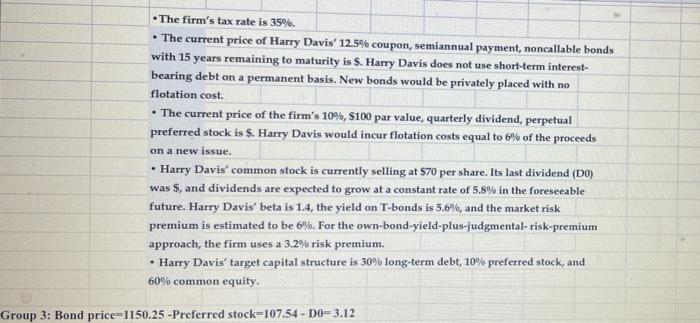- The firm's tax rate is 35%. - The current price of Harry Davis' 125% coupon, semiannual payment, noncallable bonds with 15 years remaining to maturity is $. Harry Davis does not use short-term interestbearing debt on a permanent basis. New bonds would be privately placed with no flotation cost. - The current price of the firm's 10%,$100 par value, quarterly dividend, perpetual preferred stock is \$. Harry Davis would incur flotation costs equal to 6% of the proceeds on a new issue. - Harry Davis' common stock is currently selling at $70 per share. Its last dividend (D0) was 5 , and dividends are expected to grow at a constant rate of 5.8% in the foreseeable future. Harry Davis' beta is 1.4, the yield on T-bonds is 5.6%, and the market risk premium is estimated to be 6%. For the own-bond-yield-plus-judgmental-risk-premium approach, the firm uses a 3.2% risk premium. - Harry Davis' target capital structure is 30% long-term debt, 10\% preferred stock, and 60% common equity. Group 3: Bond price =1150.25-Preferred stock =107.54D0=3.12 1. Sheules the cests be histerical (cmbedded) costs ar new (nkiginal) cesis? Why? 5. What is the firen's cuat uf perferred steek? 2. Should the component costs be figured an a before-tax or an after-tax basis? Why? 3. Should the costs be historical (embedded) costs or new (marginal) costs? Why? 4. What is the market interest rate on Harry Davis' debt, and what is the compencat cost of the tjis debt for the WACC purposes? 5. What is the firm's cost of preferred stock? - The firm's tax rate is 35%. - The current price of Harry Davis' 125% coupon, semiannual payment, noncallable bonds with 15 years remaining to maturity is $. Harry Davis does not use short-term interestbearing debt on a permanent basis. New bonds would be privately placed with no flotation cost. - The current price of the firm's 10%,$100 par value, quarterly dividend, perpetual preferred stock is \$. Harry Davis would incur flotation costs equal to 6% of the proceeds on a new issue. - Harry Davis' common stock is currently selling at $70 per share. Its last dividend (D0) was 5 , and dividends are expected to grow at a constant rate of 5.8% in the foreseeable future. Harry Davis' beta is 1.4, the yield on T-bonds is 5.6%, and the market risk premium is estimated to be 6%. For the own-bond-yield-plus-judgmental-risk-premium approach, the firm uses a 3.2% risk premium. - Harry Davis' target capital structure is 30% long-term debt, 10\% preferred stock, and 60% common equity. Group 3: Bond price =1150.25-Preferred stock =107.54D0=3.12 1. Sheules the cests be histerical (cmbedded) costs ar new (nkiginal) cesis? Why? 5. What is the firen's cuat uf perferred steek? 2. Should the component costs be figured an a before-tax or an after-tax basis? Why? 3. Should the costs be historical (embedded) costs or new (marginal) costs? Why? 4. What is the market interest rate on Harry Davis' debt, and what is the compencat cost of the tjis debt for the WACC purposes? 5. What is the firm's cost of preferred stock









